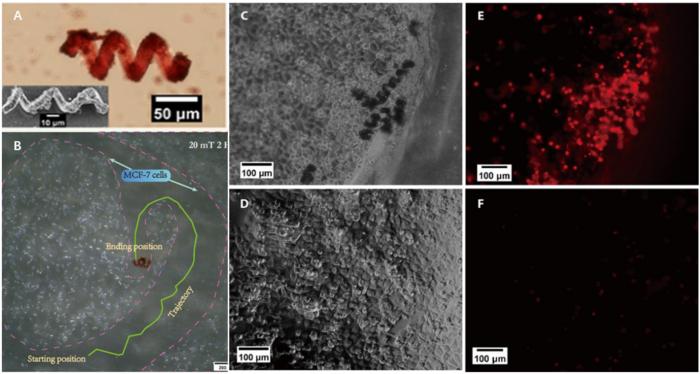| Jun 06, 2023 |
Magnetic microrobots with folate targeting for drug delivery
|
|
(Nanowerk News) The effectiveness of microrobots in aiding drug delivery into cells is currently limited, which impacts their therapeutic value. To overcome this, researchers have integrated the cancer-targeting compound, folic acid (FA), into microrobots. This allows for increased drug absorption by cancer cells through a process known as receptor-ligand-mediated endocytosis. Consequently, researchers developed a drug delivery system that can pinpoint lesion areas using magnetic fields and deliver drugs directly into the cell's cytoplasm via endocytosis.
|
|
These findings were published in the Journal of Cyborg and Bionic Systems ("Magnetic Microrobots with Folate Targeting for Drug Delivery").
|
|
Microrobots, which aren't tethered, have displayed impressive capabilities in several areas such as minimally invasive surgery, drug delivery, environmental clean-up, and tissue engineering. One common way to actuate these microrobots is through magnetic fields, which offer safety, deep tissue penetration, and excellent temporal and spatial control. However, when delivering drugs, these microrobots can only distribute the drug around the cells, but not aid in their entry into the cells. This limitation might diminish the treatment's effectiveness, as the drug may not reach its intended target inside the cell.
|
|
To augment the drug's efficiency, microrobots need to have precise targeting capabilities. To this end, the researchers incorporated folic acid into the microrobots to enhance cancer cell targeting and drug absorption by the cells. The overexpression of the FR on cancer cells allows FA to facilitate drug uptake through receptor-ligand-mediated endocytosis.
|
 |
| The introduction of FA improved the tumor targeting ability of the microrobots, which can be manipulated by magnetic fields, producing an obvious anticancer effect. Images (A), movability (B), and anticancer effect (C-F) of folate-targeted magnetic microbrorobot. (Image: Cyborg and Bionic Systems)
|
|
The engineered magnetic microrobot system is composed of biodegradable gelatin methacryloyl (GelMA)-based ABF microhelix and FA-loaded Fe@ZIF-8 (MOF) nanoparticles. Therapeutic drugs like DOX can be loaded into the microrobots' hydrogel network for cancer treatment. With an external rotating magnetic field, the microrobot can be guided and positioned at the lesion site to concentrate therapeutic drugs around the cells. Full binding of FA on the microrobots and FR on the cancer cells' surface can instigate endocytosis, resulting in MOF(FA) and DOX entering the cells. Concentrating the microrobots near the cells heightens receptor-ligand interaction and improves therapeutic efficiency.
|
|
The study demonstrated that microrobots with FA inhibited cell growth more significantly than those without FA. Hence, the ABF-MOF(FA) drug delivery system, combining magnetic manipulation with FA's active targeting, shows promising potential for cancer treatment.
|
|
The encapsulation and release abilities of the drug were tested with a release curve, showing that the GelMA-based microrobot possessed these capabilities. The targeting ability of FA was confirmed by MTT assay and live/dead staining experiments. Further, motion control and cell experiments showed that the microrobots could be precisely controlled by a magnetic field to perform specific tasks. Ultimately, DOX-loaded, folate-targeting magnetic microrobots showed significant anticancer effects within 24 hours of being guided to the assigned location by a magnetic field.
|
|
This folate-targeting magnetic microrobot system holds significant promise in cancer treatment, given its high drug-loading capacity, navigational control, and increased cancer cell targeting and inhibition abilities.
|

